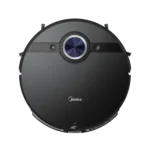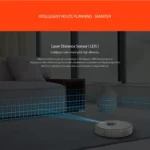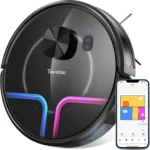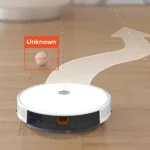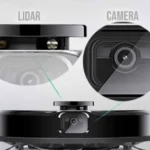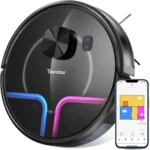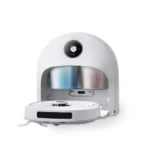As technology continues to evolve, it’s no surprise that even our cleaning tools are becoming more advanced. Smart vacuum cleaners have taken the market by storm, revolutionizing the way we clean our homes. But have you ever wondered how these machines work so efficiently? The key lies in their advanced sensors and mapping technology, which work in tandem to create a smart cleaning experience. In this article, we’ll delve into the details of how smart vacuums use sensors and mapping technology to clean efficiently. From optical sensors to laser-based navigation, we’ll explore the various technologies that enable these machines to deliver a thorough cleaning while saving you time and energy. So, let’s get started!
Sensors in Smart Vacuums
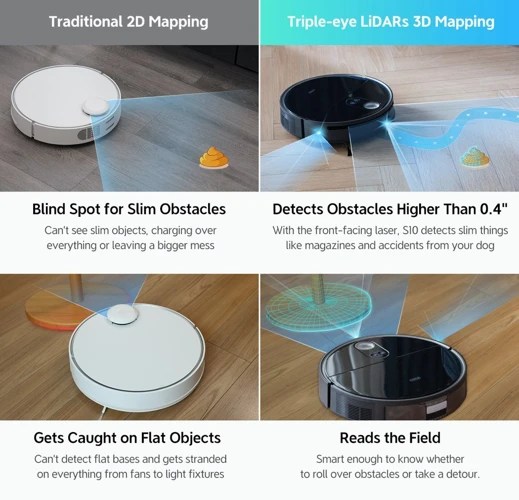
Smart vacuums are a modern technological wonder that has revolutionized the way we clean our homes. One of the key features that sets them apart from traditional vacuum cleaners is their use of advanced sensors. These sensors help the smart vacuum to navigate around your house more efficiently and effectively, allowing it to clean every nook and corner of your home. In this article, we’ll delve deeper into the world of sensors in smart vacuums and explore how they work. So, let’s get started! And if you are interested in how smart vacuums can help the elderly or disabled, check out this link.
1. Optical Sensors
Optical sensors are a key component of smart vacuum cleaners. These sensors use light to detect obstacles and navigate spaces. They work by emitting a beam of light and measuring the reflection of that light off nearby objects. This allows the vacuum to build a map of the room and detect obstacles in its path.
There are different types of optical sensors that smart vacuums use:
| Sensor Type | How it Works | Advantages |
|---|---|---|
| Cliff Sensors | Uses infrared light to detect drop-offs, such as stairs or ledges, and prevent the vacuum from falling. | Prevents damage to the vacuum and potential harm to pets or humans. |
| Wall Sensors | Uses infrared light to detect walls and objects to avoid collisions and clean along edges more efficiently. | Prevents damage to furniture and walls and provides more thorough cleaning. |
| Optical Flow Sensors | Uses a camera and optical flow algorithm to track the vacuum’s movement and position in the room. | Allows for more accurate mapping and navigation, especially in larger spaces. |
Optical sensors enable smart vacuums to navigate and clean efficiently without getting stuck or causing damage. They provide a safer and smarter cleaning experience. To learn more about the benefits of smart vacuums, check out the benefits for pet owners or how to schedule a smart vacuum.
2. Infrared Sensors
Infrared Sensors are also known as IR sensors. They work by emitting and detecting infrared radiation. There are two types of IR sensors used in smart vacuums: reflective and non-reflective IR sensors. Reflective IR sensors detect the surface under the vacuum, while non-reflective IR sensors detect objects and obstacles.
| Advantages | Disadvantages |
|---|---|
| Highly accurate in detecting objects and obstacles | Require frequent calibration |
| Can detect dark and light-colored objects equally well | Can be disrupted by sunlight or other IR sources |
| Operate well in low-light conditions | Can be affected by humidity or fog |
Some smart vacuums like the iRobot Roomba 980 use IR sensors in conjunction with other sensors for better navigation and obstacle avoidance. IR sensors are also used for detecting stairs and drop-offs, preventing the vacuum from falling off the edge.
If you want to learn more about the benefits of a smart vacuum compared to a traditional vacuum, check out our comprehensive comparison. Additionally, did you know that a smart vacuum cleaner can have a positive impact on the environment? Read our article on smart vacuums and the environment to learn more.
3. Ultrasound Sensors
Ultrasound sensors in smart vacuum cleaners use high-frequency sound waves to detect obstacles and map out the cleaning area. These sensors send out ultrasound waves and then measure the time it takes for the waves to bounce back to the machine. This enables them to calculate the distance and location of nearby objects.
Here are some advantages of ultrasound sensors in smart vacuum cleaners:
- Accuracy: Ultrasound sensors are highly accurate and can detect small objects, even down to a few millimeters in size.
- Low Power Consumption: Ultrasound sensors consume very little power, making them an energy-efficient option.
- No Interference: Unlike other sensors, ultrasound waves are not affected by interference from other sources, such as light or heat.
Using ultrasound sensors, smart vacuums can effectively navigate around furniture, and other obstacles while also avoiding collisions. They also help detect areas that need more attention, such as particularly dirty spots, ensuring a thorough cleaning. Additionally, the use of ultrasound sensors enables smart vacuums to avoid falls down stairs or other changes in elevation within the home.
All in all, the use of ultrasound sensors in smart vacuums is significant as it enables them to achieve not only a precise and accurate cleaning job but also ensures their energy efficiency. This makes them an ideal choice for maintaining your home while also reducing your carbon footprint.
4. Tactile Sensors
Tactile sensors are one of the newest additions to the features of smart vacuum cleaners. These sensors measure the force and pressure on the device when it makes contact with any object during its cleaning process. With the help of these sensors, the vacuum cleaner can adjust its cleaning performance according to the surface it’s cleaning on.
The main purpose of tactile sensors is to help the smart vacuum cleaner detect and navigate around obstacles. When the device detects an obstacle, it slows down or stops completely, then redirect its path to ensure it doesn’t damage the object. The tactile sensors are positioned on the front of the vacuum cleaner to detect and avoid any obstacles it may come into contact with during cleaning.
| Tactile Sensors | Function | Benefit |
|---|---|---|
| Tactile Bumpers | Detect when the vacuum cleaner makes contact with an object | Alerts the device to the presence of an object before it collides with it |
| Tactile Buttons | Detect pressure changes when vacuum cleaner moves over different surfaces | Adjusts the suction power according to the surface, ensuring thorough cleaning |
| Tactile Strips | Located along the underside of device | Alert the vacuum cleaner to any objects on the ground, and can also assist in detecting edges and drops to prevent the device from falling off stairs or ledges |
This feature is especially helpful for homes with children or pets, as it can prevent collisions and damage to both the vacuum cleaner and any household items. Additionally, tactile sensors can also help the device determine the height of a surface, allowing it to switch between floor types without any manual adjustments.
The addition of tactile sensors to smart vacuum cleaners has greatly improved their efficiency and safety. With the ability to detect obstacles and adjust suction power, these devices provide thorough cleaning without damaging household items. These sensors have helped to make the cleaning process more convenient and effortless than ever before. Learn more about smart vacuum cleaners and how they improve indoor air quality by clicking on this link: Smart Vacuum Cleaner Improve Indoor Air Quality.
Mapping Technology
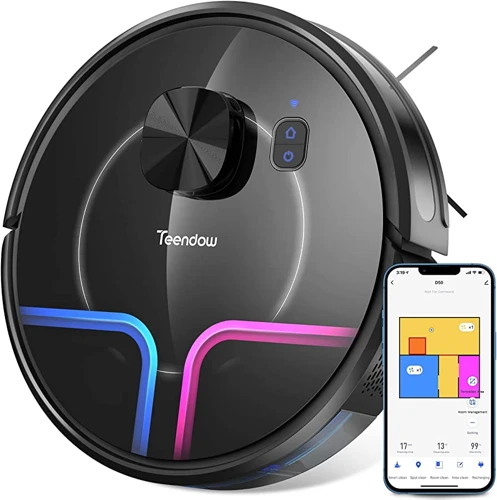
As smart vacuums become more advanced, they are equipped with mapping technology that helps them navigate around homes with increasing accuracy. With the help of various sensors, these robotic cleaners create a map of the environment, identifying the location of furniture and other obstacles. This mapping technology is integral to the efficient operation of smart vacuums, enabling them to clean in a methodical and thorough manner. Let’s delve deeper into the mapping technology used by smart vacuums and the benefits that it brings.
1. Simultaneous Localization and Mapping (SLAM)
Simultaneous Localization and Mapping, which is commonly referred to as SLAM, is the technology that allows smart vacuum cleaners to map out their surroundings while simultaneously determining their own location within that map. This process is achieved through the use of various sensors and algorithms.
SLAM algorithms use sensor fusion to combine data from multiple sensors such as optical, infrared, ultrasound, and tactile sensors to create a map of the area being cleaned. Once the map is created, the algorithm then uses the data collected to locate the vacuum cleaner within that map.
One of the key benefits of SLAM is that it allows the vacuum cleaner to adapt to different environments, such as switching from hardwood floors to carpeted areas. This is because SLAM algorithms are able to dynamically adjust the map based on new data and information collected.
The following table summarizes the key features of SLAM technology:
| Feature | Description |
|---|---|
| Sensor Fusion | Combines data from multiple sensors to create a map of the area being cleaned. |
| Adaptive Mapping | Allows the vacuum cleaner to adjust the map based on new data. |
| Real-time Mapping | Creates a map that is continually updated in real-time. |
| Environment Recognition | Allows the vacuum cleaner to recognize and adapt to different environments. |
SLAM is a powerful technology that plays a crucial role in the efficiency and effectiveness of smart vacuum cleaners. By allowing the vacuum cleaner to map out its surroundings and determine its own location, SLAM enables the cleaner to navigate through obstacles and avoid collisions, resulting in a more thorough and efficient cleaning of your home.
2. LiDAR Mapping
LiDAR mapping, or Light Detection and Ranging, is a remote sensing technology that uses lasers to measure distances and create digital maps of the environment. Smart vacuums equipped with LiDAR sensors create a detailed 3D map of a room, which allows them to effectively navigate and clean the space.
Here are the key benefits of LiDAR mapping technology in smart vacuums:
- High Precision: LiDAR sensors can accurately measure the distance between the object and the vacuum, giving the vacuum important information about the layout of the room. This enables smart vacuums to create more efficient cleaning paths.
- Large Range: LiDAR mapping technology allows smart vacuums to map an entire room or multiple rooms in a short period of time, making them ideal for cleaning larger spaces.
- Robustness: Unlike other sensors, LiDAR sensors can effectively work in low light or complete darkness, making them suitable for cleaning at any time of the day.
- Real-Time Updates: As LiDAR sensors continuously scan the environment, the vacuum can immediately detect any movements or changes in the room. This allows the vacuum to adapt and change its cleaning path in real-time, based on the situation.
LiDAR mapping technology plays a vital role in the efficiency and effectiveness of smart vacuums. By creating a detailed 3D map of the environment, vacuum robots can improve their cleaning performance and navigate their way around obstacles with ease.
3. VSLAM
Visual Simultaneous Localization and Mapping (VSLAM) is a state-of-the-art technology utilized in modern robotic vacuum cleaners. It enables them to map the home’s layout, understand their exact location within the space, and navigate autonomously to carry out the cleaning process.
Here are some key features of VSLAM:
- Cameras: Robotic vacuums that use VSLAM technology are fitted with high-quality cameras. These cameras capture images of the surrounding environment which are then analyzed by algorithms to create a map of the home.
- Object recognition: In addition to mapping the home, VSLAM algorithms are designed to recognize different objects and surfaces, which helps the vacuum cleaner to understand where it is in the house and how to get to each room. For instance, if the vacuum cleaner recognizes a couch in the room, it knows it needs to go around it.
- Real-time feedback: Visual sensors in VSLAM generate real-time feedback on the vacuum cleaner’s exact location, speed, and movements, which helps to improve accuracy and precision.
- Navigational accuracy: VSLAM enables the vacuum to know exactly where it is within the home and what areas have already been cleaned – preventing the vacuum from moving in a random direction and ensuring thorough cleaning for every corner of the room.
The use of VSLAM technology in smart vacuum cleaners is a game-changer in the world of cleaning. The powerful combination of advanced camera technology, object detection, and real-time feedback allows these devices to seamlessly navigate through homes and carry out cleaning tasks with maximum efficiency and minimal effort.
4. Room Recognition
Room Recognition is a technology that lets smart vacuum cleaners recognize different rooms in your home. It makes the cleaning process more efficient as the vacuum can clean certain rooms first, instead of randomly moving around your entire home. Here are a few ways that room recognition is achieved in smart vacuums:
- Laser-based Sensors: Some high-end vacuum cleaners use laser sensors to identify the layout of your home. These sensors emit lasers that bounce off the walls and reflect back to the vacuum, allowing it to create a virtual map of your home. This map can then be used to divide your home into different zones or rooms for cleaning.
- Camera-based Sensors: Some smart vacuums are equipped with cameras that can visually recognize different rooms. The vacuum may have to learn the specific layout of your home by being manually trained to recognize each room, but once it has done so, it can use this information to clean more effectively.
- Ceiling-based Sensors: Some smart vacuums have sensors that are installed on the ceiling of your home. This technology works by creating a digital blueprint of your home which maps out each room’s size and layout. By using this mapping feature, the vacuum cleaner can tell where it is in your home and navigate accordingly.
Room recognition is an important technology that can help smart vacuum cleaners clean your home more efficiently. By recognizing different rooms, these vacuums can create a cleaning plan that takes into account the different cleaning needs of each area.
Navigation Technologies in Vacuum Cleaners
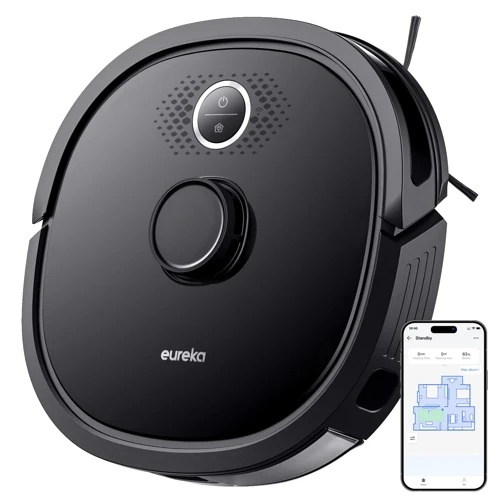
As smart vacuums became popular, manufacturers focused on improving the navigation technologies. Navigation technologies in vacuums refer to how the device moves and maps the cleaning area. With advanced sensors and mapping technology, vacuums can clean efficiently and thoroughly. There are four main navigation technologies used in vacuums today, each with its own strengths and weaknesses. In this section, we’ll explore each of them to help you find the right vacuum for your cleaning needs.
1. Random Navigation
Random navigation is the simplest type of navigation used by some smart vacuums. As the name suggests, it involves randomly traversing the floor space and changing direction when the vacuum hits an obstacle. This type of navigation does not rely on any mapping or sensing technology to clean efficiently.
The table below highlights the advantages and disadvantages of using random navigation in smart vacuums for cleaning:
| Advantages | Disadvantages |
|---|---|
| Simple programming | Cannot navigate complex floor plans |
| Lower cost | Cleaning time is longer due to inefficient cleaning routes |
| Can clean a variety of surfaces | May miss certain areas altogether or clean some areas multiple times |
| Can still pick up dirt and debris | Not suitable for large or multi-story homes |
While random navigation may seem like an outdated and inefficient method, it can still be useful for those who have a simple and open floor plan. However, for those with complex floor plans, random navigation may not provide thorough cleaning results. As technology advances, random navigation is likely to become obsolete in the world of smart vacuums.
2. Bump and Go Navigation
Bump and Go navigation is one of the basic navigation technologies used in smart vacuum cleaners. This type of navigation relies on physical contact with obstacles to change direction and continue cleaning.
How it Works:
Bump and Go navigation is quite simple. When the smart vacuum cleaner comes in contact with an obstacle, the cleaner changes direction and continues cleaning. The cleaner keeps moving in different directions until it covers the entire area.
Advantages:
The advantages of bump and go navigation lie in its simplicity and low cost. By not relying on sensors or mapping technology, bump and go navigation enables manufacturers to produce smart vacuums at a lower price point compared to other navigation technologies.
Disadvantages:
However, bump and go navigation has its limitations. By relying only on physical contact to change direction, the smart vacuum may miss some spots or not cover the entire area. It can also become stuck if an obstacle is too large.
Here is a table summarizing the pros and cons of Bump and Go Navigation:
| Pros | Cons |
|---|---|
| Simple and low cost | May miss spots or not cover entire area |
| Can get stuck on larger obstacles |
While bump and go navigation has its drawbacks, it remains a popular choice for budget-friendly smart vacuums. However, for those looking for more efficient and thorough cleaning, other navigation technologies may be a better choice.
3. Mapping-Based Navigation
Mapping-based navigation is a popular technology used in smart vacuums. This navigation system uses sensors and mapping technology to create a map of the space and then use it to navigate the vacuum cleaner around the room autonomously.
The key advantage of mapping-based navigation is that the device can create a map of the space that it is cleaning, allowing it to plan the most efficient cleaning routes. It uses high-precision sensors to create a detailed map of the room, allowing it to clean around furniture and other obstacles with ease.
This navigation system utilizes computer vision technology to process and analyze the data captured by the sensors, creating a three-dimensional map of the environment. The device can then use this information to plan the most efficient cleaning route, ensuring that all areas are covered without the need for human intervention.
One of the main advantages of mapping-based navigation is that the device can recognize and identify previously cleaned areas, allowing it to avoid needlessly cleaning them again. This can lead to significant time savings and reduced energy consumption, ensuring that the device only operates as long as necessary.
Mapping-based navigation is a highly efficient system for smart vacuums, allowing them to navigate around obstacles and clean efficiently. The table below summarizes the key benefits of mapping-based navigation in smart vacuums.
| Advantages of Mapping-Based Navigation in Smart Vacuums |
|---|
| Creates a detailed map of the environment |
| Plans the most efficient cleaning route |
| Recognizes and avoids previously cleaned areas |
| Reduces energy consumption and operating time |
4. Laser-Based Navigation
Laser-Based Navigation in Smart Vacuums
Laser-based navigation is one of the most advanced and precise technologies used in smart vacuum cleaners, which uses a laser rangefinder to create a detailed map of the surrounding environment. This map helps the vacuum to avoid obstacles and navigate through the room with pinpoint accuracy, ensuring it doesn’t miss any spots.
The technology used in laser-based navigation is called LIDAR, which stands for Light Detection and Ranging. The LIDAR system uses lasers to measure distance and create precise maps of the environment. The data from these maps is used to create a 3D model of the room, which is used to plan the most efficient cleaning route.
The LIDAR sensors used in smart vacuums can scan up to 1,800 times per second, ensuring that the map is updated in real-time as the vacuum moves throughout the room. This makes laser-based navigation one of the most reliable and efficient methods of navigation used in smart vacuums.
Advantages of Laser-Based Navigation
Using laser-based navigation has several advantages that set it apart from other technologies. Some of these advantages include:
| Advantages | Descriptions |
|---|---|
| Precision | The laser-based navigation system is incredibly accurate, allowing smart vacuums to create detailed maps of the environment and plan the most efficient cleaning route. This means that the vacuum can clean every inch of the room without missing any spots. |
| Fast and efficient | Laser-based navigation enables smart vacuums to clean quickly and efficiently. The real-time updates of the map allow the vacuum to navigate through the room with ease, avoiding obstacles and cleaning each area in the most efficient way possible. |
| Low Power Consumption | Compared to other navigation technologies, laser-based navigation uses very little power, saving energy and reducing the need for frequent recharging. |
| Smart Obstacle Avoidance | LIDAR sensors in laser-based navigation can detect even small obstacles and adjust the cleaning path accordingly. This ensures that the vacuum does not get stuck or damage any furniture in the room. |
Laser-based navigation technology helps smart vacuums to clean homes with greater precision, speed, and efficiency, while reducing energy consumption and minimizing the need for human intervention.
How Smart Vacuums Clean Your Home
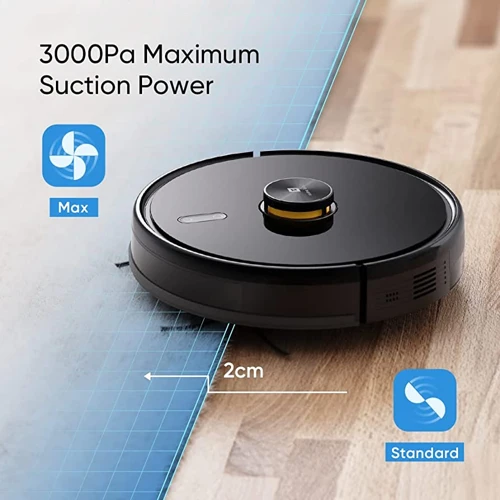
Ever wondered how a smart vacuum cleaner navigates around your home to clean effectively and efficiently? These cleaning robots are equipped with a range of advanced sensors and mapping technologies that allow them to perform complex tasks and maintain a high level of cleanliness. In this section, we’ll take a closer look at how smart vacuums navigate through your home, plan their cleaning routes, avoid obstacles, and identify the areas that need special attention. So, let’s dive into the fascinating world of robotic cleaning and see how these machines work their magic!
1. Planning Cleaning Routes
When it comes to cleaning efficiently, one of the key features of smart vacuum cleaners is their ability to plan cleaning routes. This feature allows them to cover every inch of the floor and avoid missing any spots.
But how do they plan their cleaning routes? Smart vacuums use a combination of sensors and mapping technologies to navigate your home and create a cleaning plan. Let’s take a look at some of these technologies in more detail.
| Technology | Description |
| — | — |
| Simultaneous Localization and Mapping (SLAM) | This technology uses the vacuum cleaner’s sensors to create a map of the space it needs to clean. It then uses that map to plan the most efficient cleaning route. |
| LiDAR Mapping | LiDAR stands for Light Detection and Ranging. This technology uses lasers to create a 3D map of the space. The vacuum cleaner then uses that map to plan the most efficient cleaning route. |
| VSLAM | VSLAM stands for Visual Simultaneous Localization and Mapping. This technology uses a camera to create a map of the space. It then uses that map to plan the most efficient cleaning route. |
| Room Recognition | Some smart vacuums are designed to recognize different rooms in your home. This allows them to create a cleaning plan that is tailored to each room’s layout and features. |
Once the cleaning route has been planned, the smart vacuum cleaner begins its cleaning process while constantly referring to its map to ensure it covers every inch of the floor. By planning its cleaning route beforehand, the vacuum is able to clean more efficiently and thoroughly. This means less time spent cleaning for you and a cleaner home overall.
It’s important to note that not all smart vacuums use the same technologies for planning their cleaning routes. The type of technology used can have an impact on how efficient the vacuum cleaner is and how well it performs.
2. Avoiding Obstacles
Smart vacuums are equipped with various sensors and technologies that allow them to navigate and clean efficiently without any human intervention. One of the most important features of a smart vacuum is its ability to avoid obstacles while cleaning.
Obstacle Detection Sensors
Smart vacuums use a combination of sensors, including optical sensors, infrared sensors, ultrasound sensors, and tactile sensors, to detect obstacles in their path. Optical sensors use light to detect the presence of obstacles, while infrared sensors use infrared light to determine distance. Ultrasonic sensors emit high-frequency sound waves and detect their echoes to determine the distance between the vacuum and any obstacles. Tactile sensors can detect the physical contact between the vacuum and an obstacle.
These sensors work together to create a 360-degree view of the environment around the vacuum, allowing it to detect and avoid obstacles such as furniture, walls, and other objects in its path.
Mapping Technology
Smart vacuums also utilize mapping technology to create a map of the room and identify the location of obstacles. Mapping technology, such as SLAM and LiDAR mapping, allows the vacuum to create a detailed map of the room, including the location of furniture, walls, and other objects. The vacuum can then use this map to plan a cleaning route that avoids obstacles and covers the entire room.
Navigation Technologies
Smart vacuums use various navigation technologies to avoid obstacles and clean efficiently. Mapping-based navigation is the most advanced type of navigation, as it allows the vacuum to create a map of the room and plan a cleaning route that avoids obstacles. Laser-based navigation uses lasers to create a map of the room and detect obstacles, while random navigation and bump and go navigation are simpler forms of navigation that rely on random movements or physical contact with obstacles to change direction.
Effective Obstacle Avoidance
When a smart vacuum encounters an obstacle, it will use its sensors to detect the obstacle’s location and size. It will then change direction or adjust its cleaning path to avoid the obstacle. Smart vacuums are programmed to be cautious when approaching obstacles to ensure that they do not collide with anything in their path.
The obstacle avoidance feature in smart vacuums is essential for efficient and safe cleaning. By utilizing a combination of sensors, mapping technology, and navigation technologies, smart vacuums can detect and avoid obstacles, ensuring a thorough clean without any damage to your furniture or walls.
| Sensor Type | Method of Obstacle Detection |
|---|---|
| Optical Sensors | Use light to detect the presence of obstacles. |
| Infrared Sensors | Use infrared light to determine distance to obstacles. |
| Ultrasound Sensors | Emit high-frequency sound waves and detect their echoes to determine distance to obstacles. |
| Tactile Sensors | Can detect physical contact between the vacuum and an obstacle. |
3. Identifying the Dirtiest Areas
Smart vacuums are not just designed to clean, but to clean efficiently. One of the ways they achieve this is by identifying the dirtiest areas in your home using advanced mapping technology and sensors. By doing this, they can focus their cleaning efforts on the areas that need it the most, ensuring a more thorough cleaning.
To identify the dirtiest areas, smart vacuums use sensors to detect the amount of dust and dirt in different parts of your home. These sensors include optical, infrared, ultrasonic, and tactile sensors. They work together to create a map of your home, which the vacuum uses to navigate and clean.
Once the smart vacuum has a map of your home, it can identify areas that are more heavily trafficked and therefore tend to be dirtier. It can also detect areas where there may be more dust and debris, such as near windows or doors, and focus on those areas as well.
To illustrate this, take a look at the table below, which shows how a smart vacuum might identify the dirtiest areas in a home.
| Room | Amount of Dust and Debris | Traffic | Priority |
|---|---|---|---|
| Living Room | High | High | 1 |
| Kitchen | Medium | High | 2 |
| Bathroom | Low | Medium | 3 |
| Bedroom | Low | Low | 4 |
As you can see in the table, the living room and kitchen have the highest priority for cleaning, as they have both high amounts of dust and debris and high traffic. The bathroom and bedroom, on the other hand, have lower priorities as they have less dust and lower traffic.
By focusing on the areas that need it the most, smart vacuums can clean your home more efficiently and effectively. This not only saves you time but also ensures that your home is as clean as possible.
4. Scheduling Cleaning
Smart vacuums make cleaning easier by scheduling cleaning automatically, so your floors are always clean even when you’re not at home. This means you can have a clean and tidy home without the effort of manually cleaning.
Scheduling Cleaning is one of the most useful features of smart vacuums, enabling them to clean your home on a regular basis without the need for manual intervention. Most smart vacuums are equipped with a scheduling function which lets you set the cleaning time for specific days of the week or even specific times during the day. This allows you to ensure that your home is cleaned at your preferred time and schedule, without requiring your presence.
Some smart vacuums also allow you to schedule cleaning via a mobile app, which can be accessed from your smartphone or tablet. With the app, you can set the cleaning schedule from anywhere, creating a cleaning timetable that fits your lifestyle.
The scheduling feature of smart vacuums offers significant benefits, including:
| Benefits | Explanation |
| Convenience | You can schedule the cleaning at your desired time and days, which means you don’t have to remember or worry about cleaning schedules. |
| Efficiency | You don’t have to spend your time scheduling cleaning. The vacuum will automatically clean at the designated time, allowing you to focus on other important things. |
| Energy Conservation | The scheduling feature helps to conserve energy by avoiding running the vacuum unnecessarily. |
| Cost-effective | You can save money on electricity bills if you schedule cleaning times during off-peak periods when electricity costs are lower. |
Scheduling cleaning is a valuable feature of smart vacuums that provides an easy and efficient solution to maintaining a clean home. The ability to schedule cleaning reduces the burden on homeowners and ensures their homes are always clean without the need for manual intervention.
Advantages of Smart Vacuums
As we move toward a smarter and more connected world, the use of smart vacuums is becoming increasingly popular. These innovative devices offer a range of benefits that weren’t possible with traditional vacuum cleaners. In this section, we will explore the many advantages of smart vacuums, including saving time, being more energy efficient, reducing human error, and providing a more thorough cleaning experience.
1. Time-Saving
Smart vacuum cleaners are equipped with advanced technologies that make cleaning more efficient than ever before. One of the main advantages of these devices is the amount of time they save for their users. Let’s take a closer look at how smart vacuums save time in the table below:
| Traditional Vacuum Cleaners | Smart Vacuum Cleaners |
|---|---|
| Require manual operation and need to be pushed around the house | Can be remotely controlled via a smartphone app, meaning that users don’t have to manually operate the device, and can instead focus on other tasks |
| Require users to move furniture out of the way to ensure a thorough clean | Have sensors that allow them to detect and navigate around obstacles, meaning that users don’t have to move furniture or other items out of the way |
| Can only be used during specific times when users are at home, due to noise and disruption | Are generally quieter than traditional vacuum cleaners, and can be scheduled to clean at any time, meaning that users can get on with their day without being disturbed |
As we can see from the table, smart vacuum cleaners provide a range of time-saving benefits over traditional vacuum cleaners. Not only can they be remotely controlled and scheduled to clean automatically, but their sensor technology also means that users don’t have to manually move furniture or make sure that they are present during the cleaning process. Smart vacuum cleaners are a highly efficient and convenient solution for keeping homes clean and tidy.
2. Energy Efficient
One of the key advantages of smart vacuum cleaners is their energy efficiency. These vacuums have been designed to consume less power while delivering optimal cleaning performance. Let’s take a closer look at some of the reasons why smart vacuums are energy efficient.
| Reasons for Energy Efficiency | Description |
| Sensors | Smart vacuums are equipped with a variety of sensors that allow them to navigate around your home, detect the dirtiest areas, and measure the size of the room. By doing so, they can create an optimized cleaning route that minimizes the need for backtracking and wasted energy. |
| Mapping Technology | Mapping technology helps smart vacuums create a detailed map of your home, which makes it easier for them to navigate around furniture and avoid bumping into obstacles. By doing so, they can use their battery efficiently and get more cleaning done per charge. |
| Intelligent Navigation | Smart vacuums use intelligent navigation systems to clean your home, which means they don’t waste energy by going over the same area multiple times. They also know when to stop cleaning and return to their charging dock, which helps reduce energy consumption. |
| Low Power Consumption | Most smart vacuum cleaners are designed to consume less power than traditional vacuums. They use efficient motors and batteries, which help them perform optimally without using too much energy. |
The energy efficiency of smart vacuum cleaners is a significant advantage. Not only does it help save on your electricity bill, but it also means you won’t have to worry about charging your vacuum as often. Plus, with the added benefits of sensors, mapping technology, and intelligent navigation, you can be sure that your smart vacuum will provide a thorough and efficient clean every time.
3. Reducing Human Error
One of the major advantages of smart vacuum cleaners is their ability to reduce human error during the cleaning process. With traditional vacuum cleaners, users may accidentally miss or overlook certain areas, resulting in a less thorough cleaning. However, smart vacuums incorporate advanced technologies that allow them to clean efficiently with minimal human oversight.
Here are some ways smart vacuums reduce human error:
| Technology | Description |
|---|---|
| Mapping Technology | Smart vacuums use mapping technologies like SLAM and LiDAR to create a map of the area to be cleaned, which helps them to navigate and clean more efficiently, without missing any spots. |
| Sensors | The sensors in smart vacuums allow them to detect obstacles and adjust their cleaning paths accordingly, preventing them from getting stuck or missing areas. They can also detect dirty spots and concentrate cleaning efforts in those areas. |
| Automated Scheduling | With the ability to schedule cleaning sessions, smart vacuums can clean on a regular basis without any input from the user. This means that the cleaning process is consistent and thorough, without any human error or oversight. |
By incorporating these advanced technologies, smart vacuums greatly reduce the chance of human error during the cleaning process, resulting in a more efficient and thorough cleaning. Users can enjoy a clean home without the stress of having to manually clean every inch of their floors.
4. More Thorough Cleaning
Smart vacuums use their sensors and mapping technologies to provide more thorough cleaning than traditional vacuums. These vacuums are designed to clean every corner of your home, leaving no area untouched. Let’s take a look at some of the ways in which smart vacuums offer more thorough cleaning.
| Feature | Description |
|---|---|
| Multi-Surface Cleaning | Smart vacuums are equipped with sensors that can detect different surfaces and adjust their cleaning settings accordingly. Whether it’s carpet or hardwood floors, these vacuums can provide thorough cleaning on all surfaces. |
| Advanced Filtration | Smart vacuums often come with advanced filtration systems that can capture even the finest dust particles. This means that not only do they clean thoroughly, but they also improve indoor air quality. |
| Dirt Detection | Some smart vacuums are equipped with sensors that can detect areas with the highest concentration of dirt and debris. This allows the vacuum to concentrate its cleaning efforts on these areas for a more thorough clean. |
| Automatic Recharge | When the battery gets low, some smart vacuums will automatically dock themselves to recharge. This means that they can continue cleaning without any interruption or downtime, ensuring a more thorough clean. |
Combined, these features help smart vacuums clean more thoroughly than traditional vacuums. They save time, improve indoor air quality, and provide a deep clean that’s unattainable by old-style vacuums. With smart vacuums, you can be confident that your home is as clean as it can possibly be.
Conclusion
In conclusion, smart vacuum cleaners have revolutionized the way we approach cleaning our homes. With the help of advanced sensors and mapping technology, these vacuums can clean efficiently, leaving our floors and carpets spotless.
Optical sensors, infrared sensors, ultrasound sensors, and tactile sensors all work together to detect obstacles and navigate around them. This technology ensures that the vacuum is not only able to navigate around furniture and walls, but also to detect and avoid objects on the floor.
When it comes to navigation, smart vacuums use a variety of technologies, including random navigation, bump and go navigation, mapping-based navigation, and laser-based navigation. Each technology has its own advantages and disadvantages, but all are designed to optimize cleaning routes and avoid obstacles.
The advantages of smart vacuums are clear: they save time, energy, and reduce human error. With more thorough cleaning capabilities, they enable you to spend your time doing the things you love.
Overall, smart vacuum cleaners are a smart investment for any homeowner looking to keep their home clean with minimal effort. With advanced sensors and mapping technology, these vacuums can efficiently clean your floors and carpets, leaving you with more time to enjoy the things that matter most.
Frequently Asked Questions
1. How do smart vacuums know where to go?
Smart vacuums use sensors and mapping technology to navigate and create a map of the layout of your home.
2. Do smart vacuums clean effectively?
Yes, smart vacuums use advanced technology to clean efficiently and thoroughly. They can detect dirt and debris as well as plan cleaning routes, ensuring that they cover all areas of your home.
3. Are smart vacuums energy efficient?
Yes, smart vacuums use advanced technology to conserve energy and perform cleaning tasks efficiently, reducing energy consumption and overall costs.
4. Can smart vacuums clean carpeted floors?
Yes, smart vacuums are designed to clean different types of floors including carpeted areas. In fact, they can adjust their suction power and cleaning patterns according to the floor type to provide the best cleaning experience.
5. Can smart vacuums work without an internet connection?
Yes, most smart vacuums can function without an internet connection. However, some features like remote control or scheduling may require an internet connection to work properly.
6. How often do I need to empty the dustbin in a smart vacuum?
It depends on the size of the dustbin and how frequently you use the vacuum. In general, you should empty the dustbin after each cleaning session to ensure the vacuum maintains its suction power and cleaning efficiency.
7. How long do the batteries in smart vacuums last?
Battery life can vary depending on the vacuum model, but on average, most smart vacuums can run for at least an hour on a single charge, giving them ample time to clean a standard-sized room.
8. Can smart vacuums clean under furniture?
Yes, most smart vacuums are designed to be slim and compact, enabling them to clean under low-lying furniture like couches, tables, and beds.
9. Do smart vacuums come with warranties?
Yes, most smart vacuum manufacturers offer warranties and customer support, ensuring that you have access to help and assistance in case anything goes wrong.
10. Are smart vacuums safe to use?
Yes, smart vacuums are safe to use and have built-in safety features that prevent them from getting stuck or falling from heights. However, it is important to read the manufacturer’s instructions and recommendations before using the vacuum to avoid accidents.

